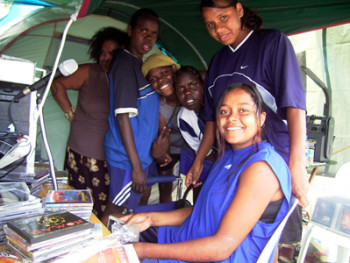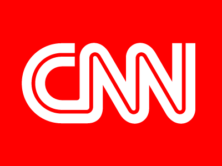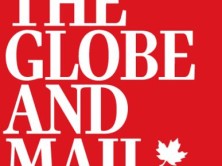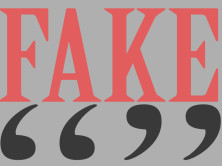
Stereotypes and clichés: fostering misunderstanding
In 1991, the national British newspaper, The Telegraph, sent a team of journalists to Holman Island in the Canadian Arctic to prepare a photo essay for its weekend magazine. Headlined “Dressed to Kill: Hunting with the Eskimos of Holman Island,” it told thousands of readers that an Inuit hunter has “no code of honour” and “is merciless and self-interested, gathering food only for himself and his family …” That was pure fabrication. The strong sense of community, interdependence, and centuries-old Inuit food-sharing system are well-documented in academic studies and Inuit oral histories.
The story mentions a “young white man who stepped off a train to stretch his legs,” whose “frozen body was discovered the following spring.” Perhaps someone had a joke at the journalist’s expense. Or maybe the journalist just made it up. Either way, he never checked the facts, and the editor never verified them. No one has ever stepped off a train at Holman – the nearest railhead is more than a thousand miles away
People laughed that one off. They did not laugh at the publication of photographs without people’s names, and the misleading cutlines (captions). They were especially offended by seeing respected elders, Jimmy and Nora Memogama, unnamed and pictured in front of what the newspaper identified as their “government-subsidised house.” In fact, that structure is not government subsidized, not a house, and not in town – it’s a hunting cabin that Jimmy Memogama built. Several community leaders and an anthropologist sent a letter to the editor; The Telegraph declined either to publish their letter or to apologize for its inaccurate and unethical reporting.
The Telegraph shows no sign of having learned from its mistakes. Seventeen years later, in March 2008, it published a photo story on the Brazilian rainforest, punningly headlined “Amazon Grace,” which labels Zo’e people “Stone Age” and describes them in romantic, “noble-savage” terms. Another national British newspaper, the Daily Mail, used the same term to refer to tribal peoples in its 2007 article, “Public School Savage.” Apparently the editors thought the headline amusing. That same year, a piece titled “Indians in Uruguay Square” in the Paraguayan newspaper, La Nacion, referred to the Aché as “Neolithic,” “out-of-date,” and “filthy.”
In 2004, the BBC, reported:
About 10,000 mainly Maori protesters…marched through the New Zealand capital against plans to nationalise the country’s beaches and seabed … fifty Maori warriors led by organiser and academic Pita Sharples performed a haka war dance
Pakeha (non-Maori people) may have thought they were learning about Aotearoa (New Zealand) news and Maori culture, but a haka is not a dance, and this particular haka was performed to express dissent, not to provoke war. Also in New Zealand, annual Waitangi Day celebrations commemorate the February 6, 1840 signing of the Treaty of Waitangi between Maori and the British Crown. Researchers studying TV news coverage of the events in 1990, 1994, and 1995 found a wide range of Pakeha stories, but only two kinds of stories about Maori: Maori made the news when they were involved with crime or “deviance”, and when they participated in welcoming ceremonies for foreign dignitaries.
Indigenous people everywhere are similarly demonized, exoticized, or both – portrayed as threats to public safety or as decorative objects from extinct cultures. Alex Karoniaktatie Jacobs calls it the “politics of primitivism.”
In all these instances, the basic fact-checking that is standard media practice, is missing. In 2008, the British NGO, Survival International, started its “Stamp it Out” campaign to try to persuade journalists to improve their work. The website carries the statement “Racism kills tribal people” and explains that “Survival’s Stamp It Out campaign aims to challenge racist descriptions, however unwitting, of tribal peoples in the media.” The website features free postcards and e-cards, along with a list of recent articles and programs “you may wish to take action on.”
Jared Diamond’s New Yorker article might well be included. His research seems to have consisted mainly of conversations with one man, Daniel Wemp, seven years earlier, when Wemp drove him around on a bird-viewing trip. There is no indication that Diamond originally intended to interview Wemp or informed him that his talk (and name) might be published. Nor is there any indication that Diamond – as either scientist or journalist – has studied the cultures, politics, or peoples of Papua New Guinea. He has ignored some of the most important principles of scientific and journalistic practice, including those requiring informed consent and verification of facts. Some of the information presented as factual could have been easily verified – for example, the hired assassin’s victim, described as paralyzed and dependent on a wheelchair, was seen walking and “carrying a large bag of dirt over his shoulder” – no spinal paralysis, no wheelchair.
From questionable research, Diamond arrives at questionable assumptions about PNG cultures, politics and peoples as a foundation for large-scale theorizing about the nature and value of “vengeance.” Patterns of revenge undoubtedly exist, but they are not the only patterns of human behaviour, or the only behaviour in Papua New Guinea.
Principled practice in journalism and science
The American Anthropological Association (AAA) Code of Ethics says “it is reasonable for researchers to expect some personal gain from their work” but they must not exploit individuals or groups and should “ensure that their research does not harm the safety, dignity, or privacy of the people.” They should consult with people they are studying to develop a mutually beneficial working relationship. They are responsible for more than “factual content.” They must “consider carefully the social and political implications of the information they disseminate”; insure that the information is “properly contextualized and responsibly utilized”; and make their sources of support transparent.
Many professional associations have similar codes. Jared Diamond and The New Yorker have claimed immunity from criticism, labelling it “anthropological” and implying that entirely different practices and principles of journalism apply. Having used both scientific and journalistic methods and helped to write ethics statements for several journalistic and scientific associations (e.g., the International Arctic Social Sciences Association and Native News Network of Canada), I disagree.
In discussing Diamond’s article, Science magazine refers to a collision of three worlds – “the world of science, specifically anthropology,” the “craft of journalism,” and the “young nation” of Papua New Guinea, “still struggling to integrate many hundreds of tribes and clans into a modern state” [italics added]. I think that is a specious argument. It infantilizes indigenous peoples and minority nations, and (without defining the term) implies that becoming “modern” is inherently good. What are we to make of ancient nations – the ancient civilizations of Iran, Iraq (and Britain, with its racist assaults and killings) – still struggling to become less violent and more “modern”?
The magazine’s distinction between journalism’s use of “real names” and science’s provision of anonymity is a red herring. First, it is inaccurate. Second, the most serious question is not whether Daniel Wemp was named, but whether he was accurately and directly quoted, was able to give informed consent, and in being named, was protected from harm to the greatest extent possible.
Motivations for research
Jared Diamond describes the personal origins of his interest in vengeance. Having seen his father-in-law “tormented by regret at his failure to take [personal] vengeance” for Holocaust horrors, he argues against “leaving justice to the state” as if those were the only possibilities. It is not uncommon for research to start from personal experience. Scientists often study diseases that affect friends or family, or seek to cope with war’s tragedies and legacies by studying violence. My own work in ethics arose from family experiences of media treatment of my father’s murder.
Diamond writes that conversations in PNG made him understand what humans have “given up” – including acknowledging that “the thirst for vengeance is among the strongest of human emotions.” He does not mention the life-saving / life-enhancing interventions, tribunals, and programs designed to help curb cycles of revenge. The “truth and reconciliation” processes in South Africa and elsewhere do not ignore the “thirst” for vengeance; they attempt to change it.
It does not take a trip to Papua New Guinea to learn that revenge is not a solution, and the wish for it engages strong emotions. Or that endless killing begets more killing, not the closure Diamond suggests. Or that some of the causes of revenge are external, rather than internal or “traditional”.
I find Diamond’s thesis problematic, because the very culture of revenge on which it turns may be linked to outside intervention. And the awkward truth is that this intervention has close connections to Diamond himself. His 2005 book, Collapse: How Societies Choose to Fail or Succeed, joined the corporate social responsibility bandwagon in praising the contributions to PNG birds and people that accompanied Chevron’s oil exploration and development. His conclusions were based on Diamond’s participation in an ornithological expedition, and discovery of a bird-watcher’s paradise on oil company property, where he reported seeing more species of birds than in the rest of Papua New Guinea.
All this took place in the midst of a struggle to improve the oil company’s image. Faced with bad press and public protest, Chevron launched an advertising campaign to counter its image (and activities) as a polluter. The ads featured Chevron’s partnership with the World Wildlife Fund (on whose board Diamond sits) and other environmentalist groups. EcoEquity director Tom Athanasiou and others call this form of “manufactured optimism” “greenwashing.” In his book, Divided Planet: The Ecology of Rich and Poor, Athanasiou links environment, poverty, class, and power. So does Wilma Mankiller, former principal chief of the Cherokee Nation. She challenges environmentalists who “should be natural allies” but “focus almost exclusively on the land and appear not to see or hear the people.” When they do “see” indigenous people, it is with a paternalistic eye. A Chevron executive proclaimed that indigenous people are “’better off with us there than if we were gone.’”
Louis Proyect criticizes Diamond for failing to dig more deeply and taking Chevron at its word, noting that Chevron’s Sumatra operation “has very little in common with the bucolic picture Diamond paints in Papua New Guinea.” According to outside observers and residents, the oil company “ruined the area in pursuit of profit. Trees died and fish disappeared from local rivers” with devastating impact on indigenous people. As for the greening of Chevron, it is worth noting that the company donated not only to environmentalist groups, but to anti-environmentalist groups such as Oregonians for Food and Shelter, “a pro-pesticide lobby”; Global Climate Coalition, “global warming sceptics”; and the National Wetlands Coalition, whose “main goal is remove obstacles to oil drilling …”
In his article, “Drilling Papua New Guinea: Chevron Comes to Lake Kutubu,” Danny Kennedy describes the damage to indigenous people – the people whom Diamond portrays as inherently and incessantly vengeful. “The 5,000 supposed local beneficiaries of the project, members of the Fasu, Foe and Kikori clans, became increasingly unhappy… 60 Foe men were arrested for protesting over inadequate royalty payments and were carried off in Chevron helicopters to a nearby jail…” Two years later, indigenous people threatened to blow up the pipeline. The royalty complaints were serious: In one instance, rivalries arose after Chevron had allocated 90% of the royalties to the Fasu and only 10% to the Foe. A similar pattern occurred in New Mexico, with Navaho and Hopi “played off against each other by a coal company.”
Thus, oil company operations and other outside intervention may have helped to create the culture of revenge that Diamond attributes to tribal traditions. Unless additional material comes to light, there is no way of knowing whether interpersonal or intertribal relations in PNG or Daniel Wemp’s stories – retold by Jared Diamond – have any bearing on an analysis of “vengeance” writ large. The “savage” / “noble-savage” view of indigenous people implies a “PNG culture” that is unlikely to exist in a nation comprising some 700 separate Papuan and Melanesian tribes.
Taking responsibility
The picture is not all bleak. There are many examples of good practice. It is possible to do some good in the world while promoting one’s career – to sell one’s work without selling out. I have heard journalists say they do not have the power to affect people, conditions, or events. We need only look at history to see that such claims do not hold water.
Consider the history-altering impact of Bob Woodward’s and Carl Bernstein’s Watergate investigations for the Washington Post, and the late 19th century New York World reporter, Jacob Riis, who helped change conditions in New York slums. His colleague, the great muckraker Lincoln Steffens, wrote that Riis “not only got the news; he cared about the news. He hated passionately all tyrannies, abuses, miseries, and he fought them. He was a ‘terror’ to the officials and landlords responsible, as he saw it, for the desperate condition of the tenements where the poor lived.”
His words and photographs sparked an investigation, demolition of some of the worst tenements, creation of a Tenement House Commission and “a collection of small parks – green spaces providing relief from the concrete urban jungle.”
In 1993, T.D. Allman and other journalists went to the former Yugoslavia, to report on ‘ethnic cleansing’.
‘I need some footage of life among the ruins,’ says Tom Aspell, an NBC correspondent … The only signs of life are occasional clumps of men… sitting out in the sunshine, in front of bombed-out buildings … Then we see an elderly couple working in their garden … She rushes to make coffee, while he shows us the garden – tomatoes, pumpkins, plums … the old woman sits down in front of Tom’s camera and is asked to describe what happened here. Immediately, she starts crying. She tells us that she and her neighbors spent nine weeks huddling in her basement … Sometimes, when one of them went for water, she didn’t make it back … This couple, whose house and life were destroyed by Serb artillery, happen to be Serbs themselves.
By interviewing people many journalists ignored, Allman got the story others missed.
As a journalist and an academic working across several disciplines, I have always maintained that, despite their separate (sometimes exclusionary) languages, methods, and mores, journalism and science have much in common. In my earlier work on “The Journalist as Ethnographer,” I argued that good science and good journalism place kindred emphasis on in-depth interviewing, contextualization, careful information-gathering / reporting, and moral integrity. I have no patience with the debate over whether journalism is a “craft” or a “profession.” It serves only as a way of dodging ethical responsibility.
The following excerpts from scientific and journalistic codes of ethics demonstrate science-journalism commonalities and highlight principles that apply to Diamond as “journalist.”
National Union of Journalists Code of Conduct (UK):
A journalist … shall strive to ensure that the information he/she disseminates is fair and accurate, avoid falsification by distortion, selection or misrepresentation … rectify promptly any harmful inaccuracies … neither originate nor process material which encourages discrimination, ridicule, prejudice or hatred …
Press Complaints Commission Code of Practice (UK)
Newspapers and periodicals must take care not to publish inaccurate, misleading or distorted material. … An apology must be published [with] fair opportunity to reply to inaccuracies. … Editors must insure that those working for them comply.
Native News Network of Canada Statement of Principles
An ethical journalism is a journalism of courage and conscience. Journalists should … present information in context … avoid identifying the names or addresses of individuals whose safety might be jeopardized … disclose any involvement in outside organizations … make respect the watchword of journalistic practice. [Italics added]
Society of American Travel Writers Ethics Code (USA)
The Society of American Travel Writers has the responsibility of accenting the need for truth and accuracy … setting standards which leave no room for dishonest or distorted stories. … Members shall deal with only those destinations of which they have first‑hand knowledge or have utilized reliable sources of information …
The Washington Post Standards and Ethics
responsibilities:
to listen to the voiceless
to avoid any and all acts of arrogance
to face the public politely and candidly …
Sweden – Code of Ethics for the Press, Radio and Television
Be critical of news sources. Check facts … Give careful thought to the harmful consequences that might follow for persons if their names are published. Refrain from publishing names unless it is obviously in the public interest. [italics added]
Finland – Guidelines for good journalistic practice
The professional ethics of a journalist involves the respecting of basic human values … human rights, democracy, peace and international understanding. A journalist must recognize … responsibility for the environment. … The human dignity and reputation of every individual must be protected.
France – Charter of the Professional Duties of French Journalists
A journalist worthy of the name:
assumes responsibility of all that he [/she] writes; considers the slander, unfounded accusations, alteration of documents, distortion of facts … to be the most serious professional misconduct; respects justice and gives it top priority …
Catalan Journalists Association – Statement on the principles of the Catalan journalism profession… press, radio and television.
To respect the rights of persons to their own privacy and image, principally in those cases or events which originate feelings of sadness or pain …
Union of Bulgarian Journalists – Rules of journalistic ethics
The journalist does not let his/her works to contribute to conflicts … use words violating the human dignity; does not oppose … but helps, people who feel they have been treated unfairly … to answer and show their side of the story …
Canadian Association of Journalists Statement of Principles
Our stories will capture … rich and diverse values, viewpoints and lives. … Reporters are responsible for the accuracy of their work. Editors must confirm [accuracy] before publication or broadcast [and] know in detail the documentation to support stories and the reliability of the sources … We will correct mistakes of fact or context promptly and ungrudgingly … avoid thoughtless stereotypes … pay our own way to ensure independence.
Society of Professional Journalists Code of Ethics (USA)
Conscientious journalists from all media and specialties strive to serve the public with thoroughness and honesty. Professional integrity is the cornerstone of a journalist’s credibility … Journalists should:
— Test the accuracy of information from all sources
— Avoid stereotyping
Minimize Harm … Ethical journalists treat sources, subjects and colleagues as human beings deserving of respect.
Journalists should:
— Show compassion for those who may be affected adversely by news coverage. Use special sensitivity when dealing with … inexperienced sources or subjects
— Recognize that gathering and reporting information may cause harm or discomfort
—Avoid conflicts of interest
— … invite dialogue with the public over journalistic conduct
— Admit mistakes and correct them promptly.
Another important resource, the Helsinki Declaration, is quoted in Carolyn Fluehr-Lobban’s excellent essay for this series.
The Australian-British journalist, John Pilger, coined the term “Unpeople” to refer to the millions, worldwide, who are marginalized, misrepresented, or omitted from media coverage.
The children of Iraq are Unpeople. So, too, are the half a million children who, according to UNICEF, die beneath the burden of unrepayable debt owed by their governments to the West … [their] eloquent defiance and courage are as important as the secret histories of their neglect.
By failing to assure informed consent to the use of their words, names, and stories and behaving as if inaccuracies and misrepresentations were inconsequential, Jared Diamond and The New Yorker have effectively rendered Indigenous people in PNG “Unpeople.”
Completing the picture
Improving media representation is only half the picture. I have yet to see a New Yorker story by an indigenous writer. There is a general absence of minority voices in major newspapers and magazines; radio and television stations; and local, regional, national, and international media-policy-making bodies.
Wilma Mankiller says the “battle to protect the human and land rights of Indigenous Peoples is made immeasurably more difficult” because “so few people know much about … the history or contemporary lives of our people.” Understanding requires historical and cultural context. The “lack of accurate information leaves a void that is often filled with nonsensical stereotypes, which either vilify Indigenous Peoples … or romanticize them. … Indigenous Peoples must frame their own issues.”
That is precisely what is happening. In exciting and world-changing ways, indigenous people are making their voices heard, through the global movement I have called the “New Media Nation.” The New Media Nation is accompanied by an explosion of music, theatre, film, and visual arts.
It looks both inward and outward, aimed at improving communication between / among indigenous peoples and between indigenous peoples and others.

Sami Radio headquarters at Karasjok, Norway. Sami Radio is radio and television service produced by and for Sami across arctic Norway, Finland, Sweden, and Russia. It is discussed in detail in Alia’s book, The New Media Nation. (Photo credit: Valerie Alia)
In Canada in 1991, a consortium of Inuit and First Nations people and organizations launched the world’s largest indigenous television network, Television Northern Canada (TVNC). In 1999, TVNC was transformed into a national television service – the Aboriginal Peoples Television Network (APTN). APTN is run and produced by aboriginal people for a nationwide, multicultural audience who receive it as part of their basic cable television package. APTN is licensed to develop and broadcast programs in English, French, and up to 15 indigenous languages, via satellite and the Internet, to a nationwide Canadian audience and a rapidly growing international audience.
In Aotearoa / New Zealand, Maori virtually reinvented the media as part of what they refer to as the “Maori Renaissance.” They organized oral history workshops and used the material from these and other projects to enrich the growing array of iwi (tribal) radio stations, newspapers, and books. In 2004, they launched the Maori Television Service and dedicated television channel. In 2008, they hosted the founding conference of the World Indigenous Television Broadcasters Network (WITBN), which is governed by an international council.
There are kindred projects throughout Africa, Latin America, Sápmi (the northern regions of Scandinavia and Russia inhabited by Sámi), Australia, and Japan.
As Lincoln Steffens, Jacob Riis and others knew, and the contemporary media ethicist, Clifford Christians, reminds us, “the global mass media are not neutral purveyors of information, but creators and shapers of culture.”
There are alternatives to the portrayals found in The Telegraph, The Daily Mail, and The New Yorker that have the potential to nurture understanding and positive social change. At the very least, journalists and scientists should follow the advice given to doctors: First, do no harm.
Sources:
Alia, Valerie:
- The New Media Nation: Indigenous Peoples and Global Communication, NY and Oxford: Berghahn, 2010
- Names and Nunavut: Culture and Identity in Arctic Canada, Berghahn, 2007
- Media Ethics and Social Change, Edinburgh: Edinburgh University Press, 2004
- “Scattered voices, global vision: Indigenous peoples and ‘the New Media Nation,” in Karim, K.H. The Media of Diaspora, London/NY: Routledge, 2003.
- Un/Covering the North: News, Media, and Aboriginal People, Vancouver: UBC Press, 1996.
Alia, Valerie & Simone Bull, Media and Ethnic Minorities, Edinburgh University Press, 2005.
Alia, Valerie, Brian Brennan & Barry Hoffmaster, eds., Deadlines and Diversity: Journalism Ethics in a Changing World, Halifax: Fernwood, 1995.
American Anthropological Association. Code of Ethics of the American Anthropological Association, AAA website (http://www.aaanet.org), June 1998.
Codes and Principles of Journalism Organizations:
- National Union of Journalists Code of Conduct (UK)
- Press Complaints Commission Code of Practice (UK)
- Native News Network of Canada Statement of Principles
- Society of American Travel Writers Ethics Code (USA)
- The Washington Post Standards and Ethics
- Sweden – Code of Ethics for the Press, Radio and Television
- Finland – Guidelines for good journalistic practice
- France – Charter of the Professional Duties of French Journalists
- Catalan Journalists Association – Statement on the principles of the Catalan journalism profession … press, radio and television.
- Union of Bulgarian Journalists – Rules of journalistic ethics
- Canadian Association of Journalists Statement of Principles
- Society of Professional Journalists Code of Ethics (USA)
Diamond, Jared:
- “Annals of Anthropology: Vengeance Is Ours: What can tribal societies tell us about our need to get even?” The New Yorker, April 21, 2008.
- Collapse: How Societies Choose to Fail or Succeed, NY: Penguin, 2005.
Fluehr-Lobban, Carolyn, “The New Yorker’s second Crisis of Conscience,”
imediaethics.org, May 14, 2009.
Jacobs, Alex K., “The Politics of Primitivism: Concerns and Attitudes in Indian Art,” Akwekon,
vol. 2, no. 3, 1986.
Kennedy, Daniel, “Drilling Papua New Guinea: Chevron Comes to Lake Kutubu,” Multinational
Monitor, March 1996.
Mankiller, Wilma, “Being Indigenous in the 21st Century,” Talk given at Quinnipiac University
to celebrate the 60th anniversary of the Universal Declaration of Human Rights, published in
Cultural Survival Quarterly, Spring 2009, 32-37.
Proyect, Louis, “Shilling for Chevron: Jared Diamond, Greenwasher,” Counterpunch, Alexander
Cockburn & Jeffrey St. Clair, eds., May 9, 2005 (http://www.counterpunch.org). -37. Science, Vol. 324. no. 5929, 15 May 2009, 872 – 74.
Shearer, Rhonda Roland, with Michael Kigl, Kritoe Keleba, & Jeffrey Elapa, Jared Diamond’s
Factual Collapse. New Yorker Mag’s Papua New Guinea Revenge Tale Untrue…Tribal Members Angry,
Want Justice, Special Report: Media. NY: imediaethics.org: Art Science Research Laboratory’s Media Ethics
Project [online] (https://www.imediaethics.org/) April 21, 2009.
Steffens, Lincoln, The Autobiography of Lincoln Steffens. NY: Harcourt, 1931.
Survival International Stamp It Out campaign. London: Survival International
(http://www.survival-international.org/campaigns/stampitout), 2009
WITBN Newsletter Issue 14, 20 February 2009(online) World Indigenous Television Broadcasters Network.
VALERIE ALIA is Adjunct Professor for the Social Sciences PhD, Royal Roads University (Canada); Visiting Professor in the Centre for Diversity in the Professions and former Running Stream Professor of Ethics and Identity at Leeds Metropolitan University (UK). She is known internationally for defining the discipline of political onomastics (politics of naming) and for her work on media ethics, arctic and indigenous communications. She has a PhD in social and political thought from York University, was the inaugural Distinguished Professor of Canadian Culture at Western Washington University and a Senior Associate of the Scott Polar Research Institute, University of Cambridge (UK). Her books include The New Media Nation: Indigenous Peoples and Global Communication (in press); Names and Nunavut: Culture and Identity in Arctic Canada; Media Ethics and Social Change; Un/Covering the North: News, Media and Aboriginal People; Media and Ethnic Minorities; Deadlines and Diversity: Journalism Ethics in a Changing World. She edits Edinburgh University Press’s Media Topics series and has worked as a wire service, print and broadcast journalist and reviewer in the United States and Canada. Her biography appears in Who’s Who in the World, Who’s Who in America,and Canadian Who’s Who.







Comments Terms and Conditions